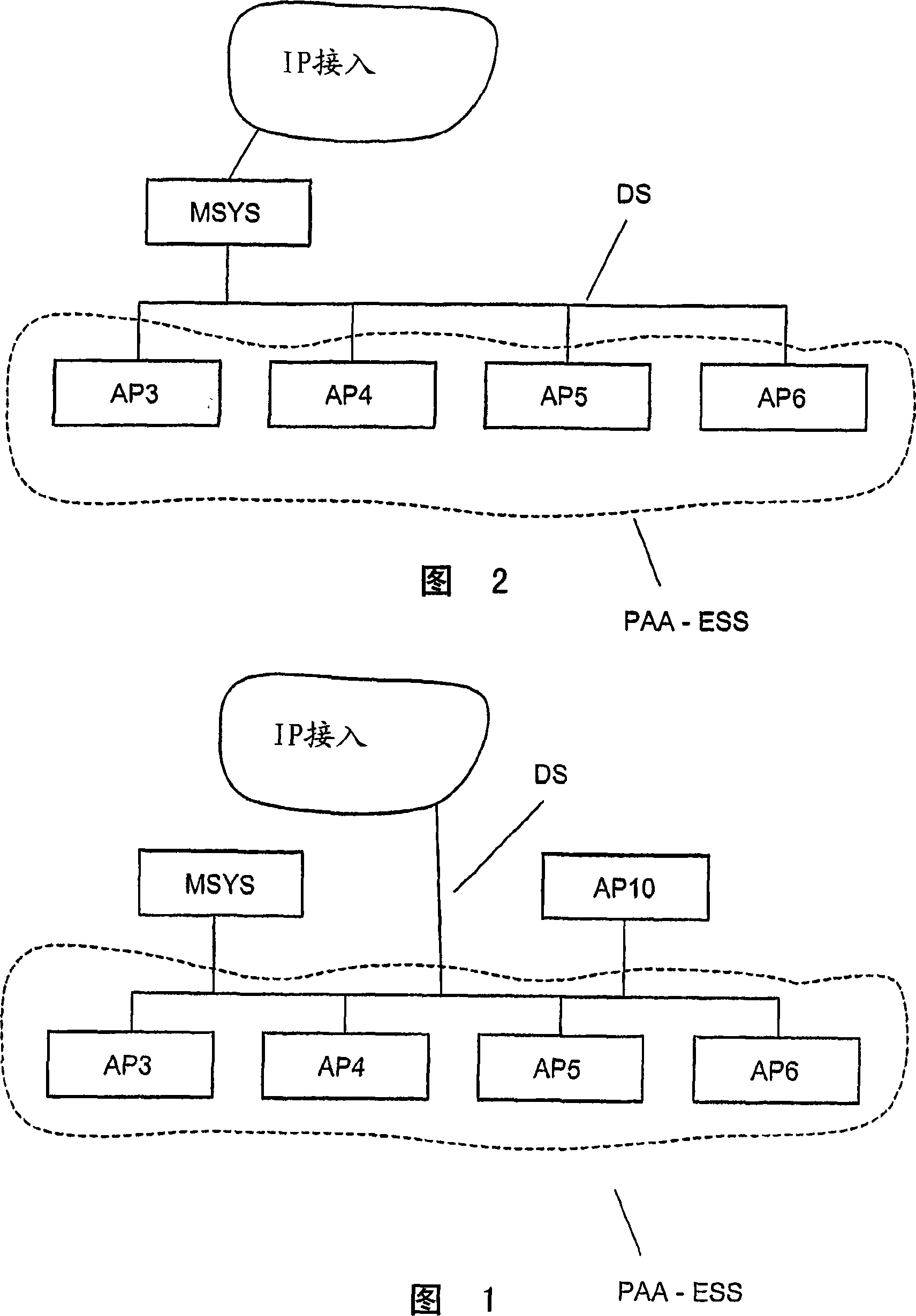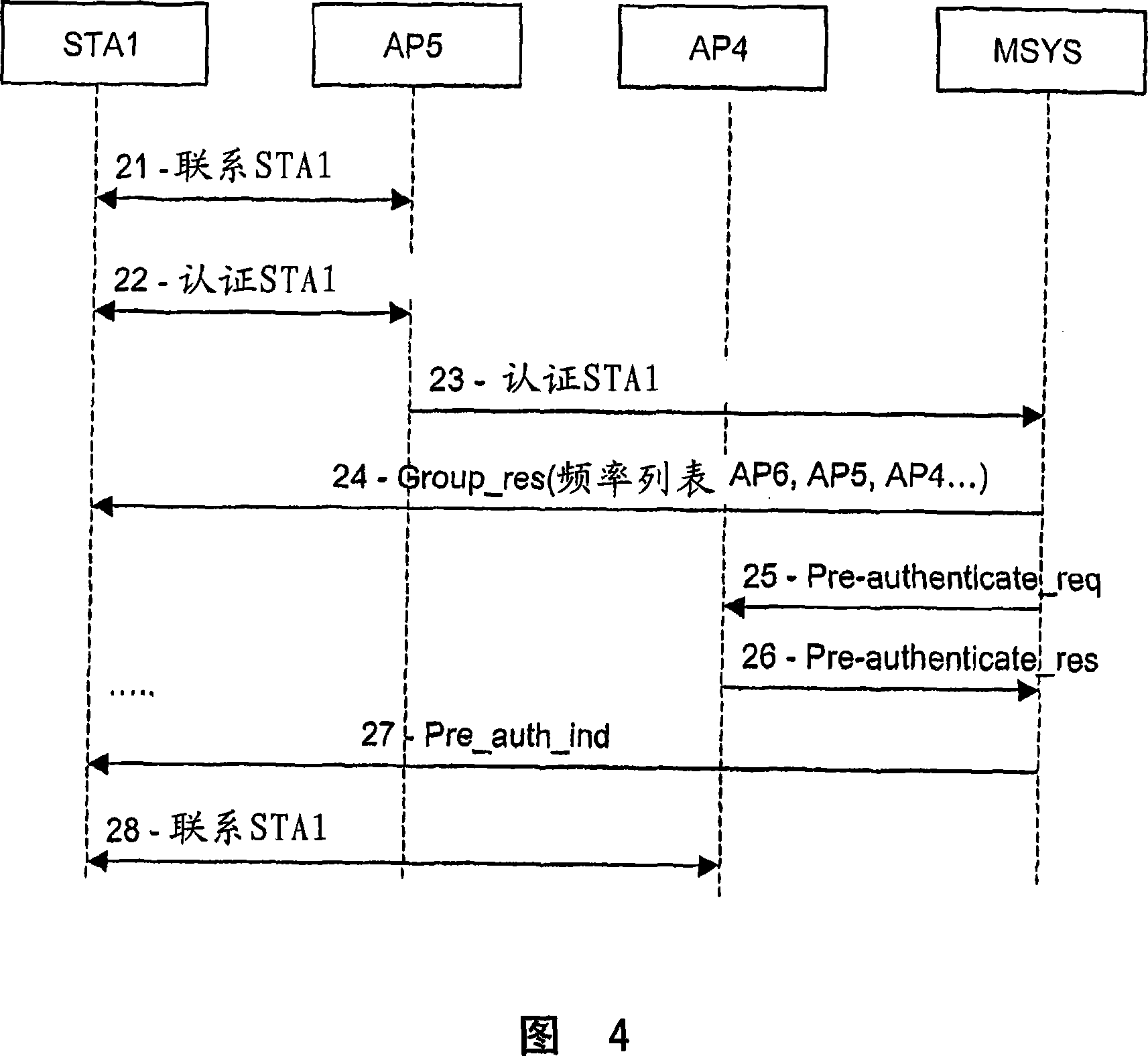Distributed pico-cell mobility
A mobile station, area technology, applied in the mobility enhancement of the IEEE802.11 MAC layer, the field of wireless radio access, and can solve the problem that the 802.11 mobility protocol is not suitable for cellular systems, etc.
- Summary
- Abstract
- Description
- Claims
- Application Information
AI Technical Summary
Problems solved by technology
Method used
Image
Examples
no. 1 example
[0024] In Fig. 1 a first embodiment of a network has been shown. The network comprises a plurality of access points AP3, AP4, AP5...AP6 connected to each other on a distributed system DS providing Internet access. According to the invention, the above access points form a pre-authentication area PAA, and the access points may advantageously define partially overlapping adjacent coverage, which may be arranged so as to be along roads or railways. An access point AP10, which is not part of the PAA area, may also be provided and connected to the distributed system. A system node MSYS may also be provided for authentication purposes according to the invention.
[0025] According to a first embodiment of the invention, the pre-authentication area PAA comprises a set of non-hierarchical access points, as shown in Fig. 1, but without MSYS nodes. Each access point forms a gateway towards the Internet. The access points are furthermore connected to each other by means of a distribut...
no. 2 example
[0034] In a second embodiment of the invention, the PA structure is hierarchical, meaning that a system node MSYS coupled to a BSS consisting of APs in a pre-authentication area provides access to the Internet. In Fig. 2, a second embodiment of a network according to the invention is provided. This network differs from the network shown in Figure 1 in that the system nodes are gateways to the Internet access network. FIG. 4 shows a timing diagram belonging to a second embodiment of the present invention.
[0035] In this embodiment, the MSYS task is to perform exclusive authentication of mobile stations entering the pre-authentication area or to provide additional authentication of mobile stations. If the authentication is passed for a given mobile station, access is provided for that mobile station.
[0036]In steps 21 and 22 respectively, the conventional steps of contacting the first encountered access point, in this case AP5, are done. Step 22 - the mobile station authe...
no. 3 example
[0043] This embodiment, similar to the one above, includes a gateway node controlling access to the Internet, as shown in FIG. 2 . Fig. 5 shows a timing diagram of a third embodiment of the present invention.
[0044] In this embodiment, there is no authentication before the access point of the pre-authentication area PAA.
[0045] After said association in step 32, in step 33 the mobile station authenticates with the gateway node MSYS. Messages are passed between associated access points and gateway nodes through a distributed system.
[0046] The mobile station then issues a group request message 34, signaling gateway nodes interested in being pre-authenticated for other access points in the pre-authentication area PAA. The mobile station may refrain from making the request if it is determined by upper layer procedures, for example as a result of the mobile station being stationary or moving in a local area that includes other access points that are not part of the pre-aut...
PUM
 Login to View More
Login to View More Abstract
Description
Claims
Application Information
 Login to View More
Login to View More - R&D
- Intellectual Property
- Life Sciences
- Materials
- Tech Scout
- Unparalleled Data Quality
- Higher Quality Content
- 60% Fewer Hallucinations
Browse by: Latest US Patents, China's latest patents, Technical Efficacy Thesaurus, Application Domain, Technology Topic, Popular Technical Reports.
© 2025 PatSnap. All rights reserved.Legal|Privacy policy|Modern Slavery Act Transparency Statement|Sitemap|About US| Contact US: help@patsnap.com



